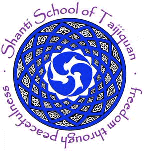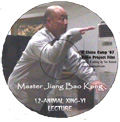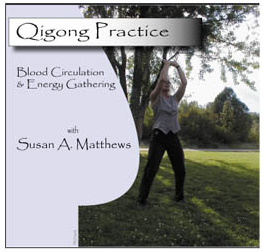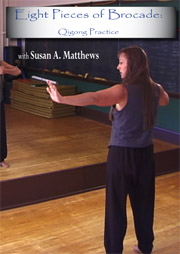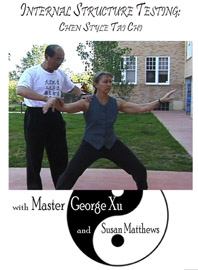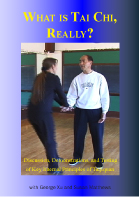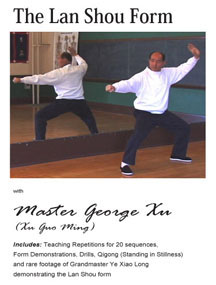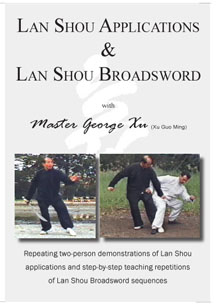SusanAMatthews.com
Susan
A. Matthews, M.S.
Shanti School of Internal Martial Arts
An Institute of Research and Education
Southwestern Colorado,
USA
970-903-5723
Contact
Susan
GeorgeXu.com
Web
site Design: Susan
Matthews
© 2003-2008
all rights reserved
No part of this web site may be reproduced without expressed permission
China Camp and Xu Guo Chang
November 30 Ė December 14, 2004
Shanghai and Suzhou, Jiangsu
By Tim Richard
1/16/2005
"Okay? . . . O-kay!" Master Xu Guo Chang repeated all day long.
"Okay," I agreed almost as often.
"Okay!" my teacher yelled enthusiastically again and again, peering closely at me, or one of my classmates, with happy eyes. Mauro, the instructor from Italy said Xu Guo Chang was employing a Taoist method of instruction. Training was like childís play, highly animated and full of clowning.
"Okay? . . . Ming bai?" he would say in his native Shanghaiese, gazing through those questioning, encouraging eyes. "Ming bai?" Understand?
"Ming bai," I reply, really not sure I understood anything.
"Okay?"
"Okay." I guess okay, maybe. Get back to me on that; maybe three to five years later.

The truth is that so much was happening inside and outside of me I couldnít tell the forest from the trees, one piece of understanding blended with others into a cluttered mass. Nevertheless, my teacher was happy, so I went along with his contagious encouragement. Itís all part of the continuing quest to know the self, to see what my teacher sees in me and what I can see in the art of internal martial arts forms and systems.
My training experience with Xu Guo Chang, a traditional Wu Style master, was memorable for me, because he triggered in me an urge to consider the abstractness of Tai Chi. Oddly, he instructed us to ignore "abstractions" and open the body to learning after its own fashion. But I believe that by not focusing on the abstract, we received a dose of new insights into it; like seeing a star only by looking slightly away from it. To me the bodyís ability and approach to learning is as abstract as the notion that it is the mind that actually moves.
I returned home from China Camp with some vacation time left, so I have spent several days recalling my camp experience and what I have learned; more precisely, what I know I learned and what I am still not conscious of learning. I am still searching the memory of the experience for what useful information I can glean. Stored somewhere in the body and mind are small memories that are like little doors into the secrets of internal martial arts. Those moves we did over and over every day for two weeks feel different, now that I am at my usual practice place, the main room of my small cabin in a valley in Southwest Colorado. I sense fresh insights waiting to be discovered, internalized physically and energetically, and perpetuated in memory. With the teacher present I often do the moves because I have to, by rote, often lacking nei jing (internal force) and an jing (invisible whipping force). Here, without the teacherís urging, I must initiate the moves. I must come up with a motivation on my own. The motivation must come from within.
Learning Tai Chi seems like a slow process. My body doesnít seem to do what I tell it. However, China Camp and Xu Guo Chang reinforced the idea that it is the mind that we have to change in order for the body to go where it is capable of going. Often, the body is more willing than the mind. The trick is to quieten the yi and allow the chi energy to loosen and flow, even be directed. Sounds simple.
Although I donít learn with the ease of a child, which would be ideal, I am finding it easier, as my practice progresses, to train my body to shift into postures that are new to it. The key is the yi. It must redirect its attention while also letting go of its spell over the body rather than blocking chi; letting the body go where it is capable of going, where it wants to go intensely.
Now that I have been able to think about my China Camp experience, I have a better sense of what to ask Xu Guo Chang if, or when, I train with him again. In fact, I will be more able to ask relevant questions of anyone I train with. I would ask more about details of form and posture. Where is the "yin"? Where is the "yang"? Work with them on the terms they are willing to discuss. I got a little information on chi movement and structure from Master Xu, but I was so much in structure that structure corrections were all he could really give me.
Not speaking the same language kept us from having in-depth discussions about internal aspects. Teaching and learning the internal information really requires dialogueĖlecture and discussion. But we were without a translator for most of our training time. When we did, our conversations were stimulating. This was one fault of the camp, if you want to look at it that way. Master Xu and we students took it as a challenge and I think we would all agree that it worked out well. Still, there are some things I bet we would all like to ask now that we are home.
We spoke through body language as much as possible, which we universally understood for the most part. Our knowledge of taijiquan was like a matrix through which we could communicate, which helped. We each spoke a dialect of a body language, you could say. Each of us had honed our "ting jing" to some level of refinement. And despite the communication obstacles, we managed to learn the first 26 moves of the traditional Wu Style form and many accompanying applications, as well as several chi na moves that can be incorporated into push hands. Xu Guo Chang prefers chi na to punching, using gravity to unbalance the opponent and throw him. Once heís down you can finish him off, I suppose. We didnít push hands much, but did some two-person exercises, including applications of form moves.
The internal aspects were another matter for me. It was difficult to key in on the internal while trying to get the sequence. It occurred to me that learning the sequence of moves requires a different part of the brain than the part it takes to apply the internal principles; even simply tapping into the energetic level has its twists and turns. Two weeks of learning the sequence of moves in the traditional Wu Style form was only a beginning to really knowing the internal foundation of the moves. I realize, or perhaps remember, that daily drilling does eventually get you where you want to be, which is to have a clear understanding of essential internal principles. The "art" is in knowing these martial "secrets."
Xu Guo Chang and all of the masters graciously offered a wealth of information that we could take home with us. On the very first day, November 2, we divided into about seven groups in that many rooms partitioned off with movable walls set up in a large conference room. Each master and his assistants passed through one room to the other giving one-hour introductions to their particular style. Traditional Wu Style has special characteristics, which Xu Guo Chang elucidated during his hour:
- You have options at all times
- The body has substantial and insubstantial parts
- In structure, each joint junction has equal pressure = song li (sip)
- Everything moves like a chain by your natural weight/force/power (gravity); this relates to his nickname, "The Gravity Man."
- . . . song (attainment). Iím not sure what this means. Later, I thought it means relaxed, everything in place and working together. He referred to this concept a number of times during training.
- Total relaxation (suŤ=relax).
- The secret is to "come back to a natural state." Zhong ding and "natural weight."
- Running away versus "falling, which is to run away with control to somewhere. (Pu tu pu ti: donít go against, donít runaway.)
On the next day, the first full day of training, Xu Guo Chang added other key concepts that he wanted our small class of about seven to incorporate in training. The first is to concentrate on the horizontal axis (or line) that passes through the hips (qua), knees and ankles. He showed us a few basic exercises and had us imitate him as we performed them. Apparently, he wanted us to concentrate on finding our center, or core, as we incorporate intricate attention to our sense of gravity. The simple movements he showed us seemed to be designed to wake the attention to the horizontal axis passing through the hips and the vertical axis along the spinal column and exiting through the perineum.
The "central core" (I didnít catch the Mandarin word he used) which seemed distinct from dantien, is a "window" to raise your attention to. It is a location, he said. My understanding was the central core was where the vertical axis of the central equilibrium (zhong ding) and the horizontal intersected, but I am not certain that this is what he meant. It seemed that where the horizontal and vertical lines meet is the central core of the body. An astute clarity of that place, or "space," is key to performing moves gracefully and with power.
We did the traditional Wu Style form slowly in order to cultivate our awareness of, and the ability to utilize, this core and its relationship with the horizontal and vertical axes. Whether in the form, in applications, or in chi na, which we practiced for hours, it was crucial to maintain that sense of core and its limits. I doubt that I achieved this goal, but now that I have had time to think about it and work on it in the privacy of my living room, I feel much closer to understanding.
It didnít take long to grasp the basic teaching routine Xu Guo Chang ended up using to teach us. It took more effort to figure out some other rather subtle intricacies that he tried to impart. This was due partly to the language barrier, but it was also due to the unique philosophical approach he took towards taijiquan and life in general. He even looked at the lack of a translator from such a perspective. He suggested that we accept it as a challenge. After practicing taijiquan long enough you attain a sense that is similar to religion, he said. You can achieve an ability that is beyond the regular senses, which is a universal level of communication and that works even though you donít speak the same language. I assume that Xu Guo Chang believed that he had reached such ability and that he incorporated it in his assessment of our abilities in Tai Chi, and also in communicating to us the knowledge he thought we were ready to learn; ready to grasp . . . even without a translator. I think he saw a neediness in us that was more important in his mind to point out. Still, we welcomed the challenge to communicate through body language, knowing very well that quality dialogue with Xu Guo Chang would be a much-desired bonus.
His approach usually worked for me, but sometimes the message didnít come across clearly. Once, he let us feel his rock-hard thigh muscles. Iím sure he intended to do more than just show off his muscles. Without translation I can only imagine what he might have intended; but, I was struck by the control he had over the large mass of muscle on the backside of his upper leg. It went through to the bone. It was virtually impossible to penetrate it with a finger or a fist. I could get only a portion of my leg to harden to any degree at all.
Xu Guo Chang said that body language can be superior to talking. This makes sense, because you can get entangled in meanings. Plus, why rely so much on language to understand what can be understood more deeply by utilizing a sense that exists beyond languageĖthat part of our being that simply and directly knows?
Guo Changís message seemed to be to cultivate this unused, but vital, ability. His attempts to make us aware of this human capacity imbued him with a mysterious quality that tugged at my curiosity. He made cryptic statements about special abilities that Tai Chi has given him. This captured my imagination. We all have our own little Tai Chi miracles. Once he said: "I have not had much education but I know a lot anyway. If you do taijiquan long enough, knowledge comes to you." He said his college-aged son and his friends come to him for answers to things even though he has not had much schooling.
I imagine itís true that once you cross a certain threshold in spiritual development through the practice of Tai Chi, you can communicate at a higher level of understanding without the hindrance of language. Xu Guo Chang shared his thoughts and opinions readily, even to the point of redirecting some questions on technique and proposing philosophical ideas instead. When we did have a translator, his answers became increasingly philosophical rather than technical. He was very quotable. I jotted down some of his comments. They all show his ideas about Tai Chi and life in general as a practice of Tai Chi.
- "Only through observing yourself can you achieve the most natural way of moving," he said. "Technology has made life too easy and we are losing awareness of the body." There is a difference between riding a bicycle and riding in a car. On a bike you still have to balance yourself.
- "Take care of yourself so you can help people. . . . Many people do martial arts to fight, but what is the use in it? . . . If you fall off your bicycle after being reckless and you canít walk, then everyone has to support you. So take care of yourself. A person is not just a person. Whatever happens to you happens to everyone, even people you donít even know."
- When he was asked if he utilized any herbs in his personal health care, he said, "Donít strive for longevity. If you are a good person you will live a long life. If you think only of yourself, whatís the use of a long life?"

When asked about what the "dantien" is doing in a particular move, he said his whole body is dantien; then suggested not to place too much attention on such an abstract concept. I thought this must be the idea until you have acquired enough practice and understanding of other more basic, but necessary, bits of knowledge. He cautioned us to shake off preconceived notions of such terms as "mind," "chi," and "zhong ding," and just do what he told us.
Someone asked about "root" and he replied not to root through the feet, because "youíll lose structure." Once you brace yourself, youíll lose your fulcrum, your balance, or line of the zhong ding. You want only to be weighted.
It occurred to me that the teacher was trying to convey only very basic information. It seemed like a very systematic and organized approach if you were planning to study with him for a few years, but with only 11 to 14 days at our disposal, most of us were looking for as much information as we could absorb, consciously or not, to take away with us.
Even though Xu Guo Chang told us to throw out preconceptions about dantien while we trained with him, he taught us an exercise that seemed to be just for developing sensitivity to the dantien. It consists of standing in place, bouncing up and down lightly just barely raising the heels and simply bending the knees enough to accommodate the up and down (or rolling) motion of the belly. Guo Chang sang a melodic and rhythmic chant while he bounced, almost in a trance-like state. I interpret this to mean that the goal is total relaxation which, once achieved, creates the options that he described on the first day and which you want to have at all times . . . among other things.
In addition to bouncing (for lack of a better term), he taught us other meditative, relaxing exercises. They were warm-ups designed to refine the connection to balance and gravity in our bodies. Tai Chi is the "ultimate" he said. "Every move you do, you want to reach the ultimate." We didnít quite understand the term and our translator revised her interpretation to say "limit." And he said that was correct. You want to reach the limit of your center of gravity. For the exercise, we were to stand, arms in front holding the ball, then rock gently until we begin to fall either forward or backward. This is intended to teach us our "limit" and so that we will know it when pushing with an opponent. He said that in fighting, the winner always finds the otherís limit and knocks him off balance. So itís important to know your own limits. Sang shi (spelling?): "Embrace your enemy, know thine enemy, become one with him."
He also told us to go very slowly in the movements. "If you go too fast, even if you achieve it, you donít really experience it," he said. "So, do it slowly to experience it." The ultimate has to be correct, together, and consistent in order to experience it, he said. Going slow is also good for healing, he added.
Lining up the head is the hardest part, he said, suggesting thinking of the process as a string of pearls. One suspended, then the next, and the next, and so on.
The applications that Xu Guo Chang showed us were very useful and authentic. In the end, I left China with enough information to work on for some time to come. It was great to have a chance to go. I liken the experience to a ship from which I have just debarked after a long voyage in search of a new land and now that I have found it a new start lies ahead. Everything is new, brimming with expectation and hopeful optimism.
In our conversation about abstractions, I remarked that mind is another abstract term that was not explained well enough. I have felt for a long time that it seems left up to me to figure out what mind is; this thing that can be directed on and through the body and into space itself. (Chi has seemed more accessible maybe because I expect to feel it physically; but it is abstract, also. Can the mind be "felt"?)
"I mean what is Ďmindí"? I asked Xu Guo Chang. He replied with a scrupulous glare that he knew what mind is.
"Mind is everywhere, so everywhere you look, yi is there," Poh Kheng, the translator said. When you hit someone, yi is already there."
Then he described "intention" as analogous to typing words and projecting them on a computer screen or printing them on paper. What is shown on the screen or paper is "fulfilled" and yi is there. The result of the action is the proof that the yi is there, I concluded.
He added that yi is like "a platform." If youíre on a different plane, you wonít get a connection to something there. This was not clear to me, but seemed valid since the fact that an accomplished martial artist was sharing it with such conviction. What he said had credibility despite my ignorance.
Unfortunately, Xu Guo Chang didnít elaborate on this notion of mind. I think someone yelled out lunchtime and we broke up for the morning. Maybe someone else can elucidate his meaning more clearly or at least their understanding of it. I do feel an odd familiarity with his descriptions. Employing it into my practice will be challenging and fun. Next chance I get, I will have to remember to ask him how these things apply. Perhaps the abstract notions of dantien and mind escape my pure understanding, but I am gaining new insights and building upon what I have discovered so far. Training really has no end, like a string of pearls that you keep adding to throughout life.
Abstract or not, I still ponder the internal question. Certainly in Tai Chi, your level of achievement is measured by your ability to learn the internal principles while simultaneously learning the surface movements. Early in your training you tend to learn the more superficial sequence of moves and the structure, then when you have them down you begin exploring the internal aspects. Yet the internal principles are the foundation. The moves you see when someone does the form are merely visible outward expressions of what is happening inside. Most practitioners know this, but many donít yet have the experience of it, which is ultimate knowledge. The way I see it right now, given my level of experience, is once you get the internal, you will progress exponentially and the more deeply you will go into unraveling the wonderful secrets of taijiquan and internal martial arts.
My goal is just to reach simultaneity and synchronicityĖwhere the parts work as a whole in total harmony, one part communicating with all others. This goal, so often evoked by our teachers, still reaches mythical proportions in my mind; promises I canít yet rely on totally with absolute abandonment, but can still imagine. One such promise, which Xu Guo Chang made is that you could use the mind, "yi," in such a way that yi surpasses the limits of the bodyís capacity to learn. The body is too slow. Itís slowness doesnít have to be a barrier. I have little concept of what shape it would take for the mind to learn and remember what the body also needs to learn and remember; but ultimately, until the body can go the speed of the mind (which I assume is something like the speed of light), the mind will have to go the speed of the body. The trick is to slow the mind down so that the body has time to learn. Later, you begin to figure out where the mind can best put its energies in order to assist the body in learning. That way, you can eventually solve that speed equation we are so accustomed to taking as conventionĖthe general ruleĖthat the body goes the bodyís speed and the mind has to suffer through it all.
The mind is like a restless energy that happens to be self-aware, yet doesnít know how to direct itself. The body seems like too small of a thing to contain the mind and its restless spirit. After it is all said and done, weíre still left with the most basic question: What are you doing internally in order to move the outside? What is the yi doing?
I would ask Xu Guo Chang and other masters questions such as: What metaphors can you share to describe these actions that words fail to express adequately? Is Chi like water, or is it like air? Both? Is it a ball? Should I feel a ball-like presence? Maybe it is the five elementsĖwater, wind, wood, fire, and metalĖtaking the essence of one at any given time. Maybe operating all five simultaneously is a mark of another level of mastery.
The restless mind is such a big issue. Martial arts practitioners are familiar with this situation. I suppose someone even invented social order to help control the mindís wild ruminations. But unless you keep the masses totally ignorant (which of course some leaders futilely try to do) youíll never control free will, because a free mind is the essence of freedom itself, of creativity, of art itselfĖthe birthright of every human being.
These days, social order looks more like social chaos. Fortunately, these days we know better what we are capable of. All over the globe people are coming up with new ideas that help to improve the well being of humans and nonhumans everywhere. More of us are seeking the consciousness needed to ensure our survival in a universe in which we are increasingly making our destructive presence feltĖto the point of sinking the Good Ship Earth while we squabble amongst ourselves over who gets the biggest piece of the ship before it sinks into infinity, into oblivion, back into a state of being in which no state exists, where humans are not even a thought, not even a whisper of a breeze along the cosmic winds of the universe.
I like to imagine that people across the world who are taking up internal martial arts intuit this and realize the value of learning much-needed discipline that can be achieved through martial training. And so here we are, the first participants in the first China Camp, enjoying a unique exchange of knowledge among cultures. After China Camp, Iím even more certain than ever that a healthy exchange of knowledge and goodwill is possible among people of different cultures and languages; and that they can come together as friends, teachers and students. And, of all things, for the art of martial encounter. At face value, our teachers and the people of China who we encountered (and who encountered us) are wonderful, sincere people who understand something about human nature and who see a little of that same understanding in us strangers with big noses and beautiful skin tone (yes, the massage therapists around the corner in Suzhou know a good thing when they see it). To be interested in learning martial arts as a common ground for interaction sweetens the pie even more.
Tim Richard
Written
Image Productions
tim@paultrichard.com
Tim Richard lives in Los Angeles. He photographs, writes and edits martial arts materials for print and video, while developing a diversity of publications. Currently, he is coordinating an annual workshop for air pollution researchers from about 15 countries/regions. He studies tai chi with Susan Matthews and George Xu, attending seminars with Wang Hao Da, Lu Gui Rong, Qian Zhao Hong, and the first China Camp. He has trained in Wu and Chen Style forms, various Qigongs, and the Lan Shou System. Besides martial arts, he also delves in the equally abstract arts of songwriting and guitar playing.

